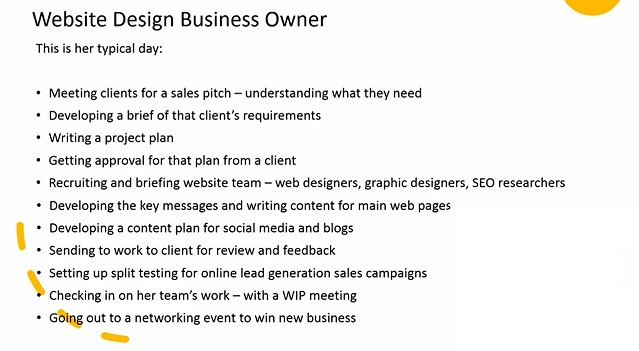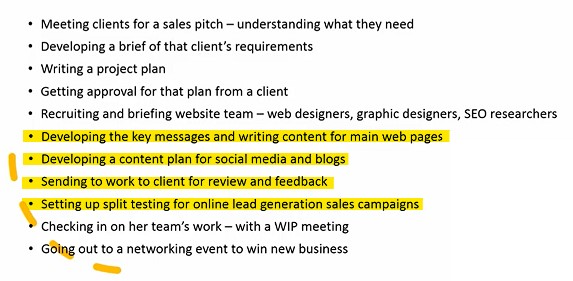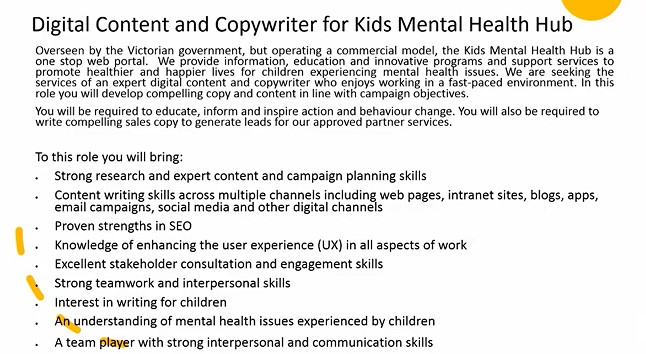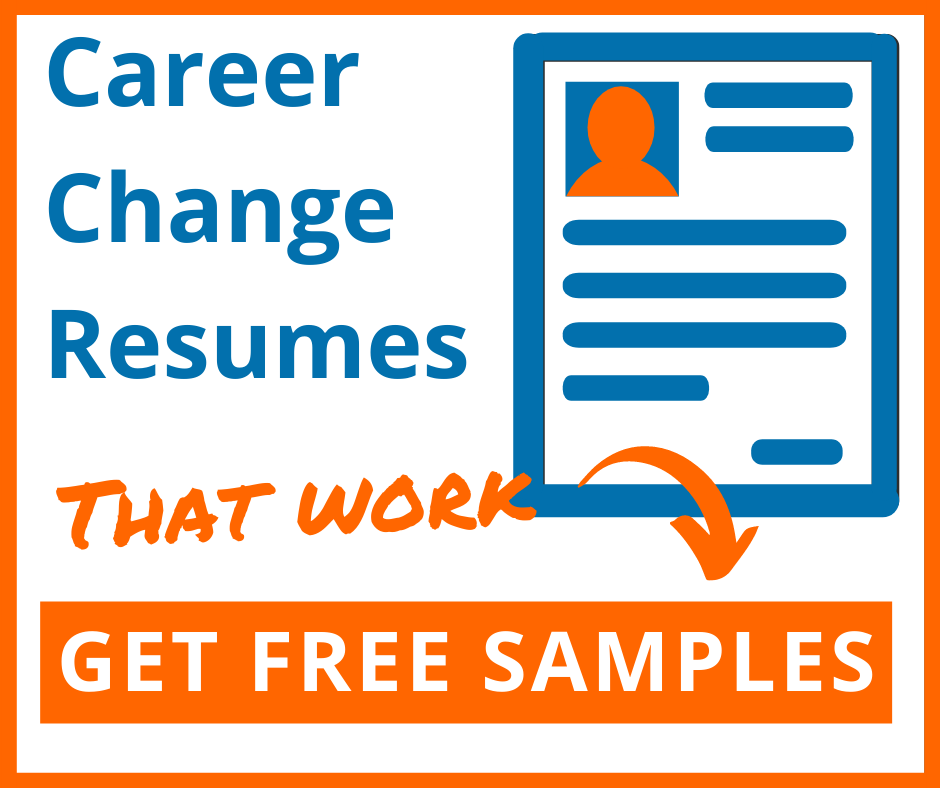Ah transferable skills!
You’ll hear this term a lot from people like me if you want to change your career.
You’ll be told to put them on your resume.
This can be really hard as even the experts who tell you to do that, can’t actually give you an effective formula for doing this.
Instead, they’ll say your transferable skills are things like:
- Teamwork
- Communication
- Leadership
- Time management
To which I say, nooooooo.
This is such blah and bad advice.
If you’re struggling with how to identify your transferable skills to put on your resume, this is your lucky lucky day.
I’m going to give you a 3-step process to unpack your transferable skills.
This will be easy to understand because it comes from real life, from one of my clients “Julia.”
Julia actually wanted to change her career from running her own website design business to becoming a content and copywriter.
But don’t worry! Even though the example is specific to Julia, you’ll still be able to follow this framework for your own situation.
But what I really want you to do is take note of the third step.
Because if you get that right, you’ll stand out above the hundreds of other people that actually don’t do this on their resume.
But before that, I need to tell you first what not to do.
Common Transferable Skills Mistakes on Your Resume
I don’t want you to follow the advice of other career coaches and resume writers that tell you to list all your transferable skills on your resume.
As I said, they might ask you to list your teamwork skills, negotiation, time management, or interpersonal skills as your transferable skills.
While they may be transferable, that’s not what the recruiter is looking for on your resume.
What the recruiter is actually looking for are skills that are relevant to the job.
So, if you go ahead and put a laundry list of any transferable skills on your resume, you’re just actually wasting space.
So, the three-step process that I will give you is going to help you identify which are your important transferable skills.
And help you express them in a compelling way on your resume.
3 Steps in Identifying Your Transferable Skills and Examples
Step 1: Do a brain dump of all the tasks you’ve done in your job, volunteer work, hobby or community work
First, create a list of the daily tasks that you do as part of your everyday life.
These tasks can come from your career, volunteer work, community work, or a hobby.
The idea is to do a brain dump of what you might do in a typical day or week so you don’t miss a thing.
So for my client Julia, this is what she does every day in her job as a website design business owner:

You can see that Julia, like any small business owner, has a really busy day – and she does many many things.
But you’ll also see that she has some skills that are transferable to the type of job that she wants to do in content and copywriting (highlighted below).

These skills are likely to be relevant to the work that she wants to do.
But we’re not 100% sure yet, so the next step is where we actually validate or verify if that’s the case by looking at what employers seek.
Step 2: Identify what your target employer wants
For the 2nd step, what I want you to do is go and look at advertisements for jobs that you’d like to do.
And look at the skills that they have listed.
Then, go back and reflect on what you’ve done as your brain dump, in terms of skills that you’ve listed from what you do every day.
See which skills match up.
These are going to be the transferable skills that we’re going to put on your resume.
In Julia’s case, she’s looking for a content and copywriting job.
So, she searches for these job advertisements to see whether the skills that she has, actually match what these types of jobs or employers are looking for.
Here’s a typical job advert.

And, as you can see, Julia has many of these skills.
You can see that in this particular job, they’re actually asking for Julia to have and demonstrate:
- Strong research and expert content and campaign planning skills.
- Strong content writing skills
- Proven strengths in SEO
- Knowledge of enhancing the user experience
- Excellent stakeholder consultation and engagement skills
- Strong teamwork and interpersonal skills
So, these are the transferable skills that Julia has because not only has she demonstrated them in about 50% of her role as a website development business owner, these are actually what the employer is looking for.
So now, what we need to do is find a way to create a resume around those transferable skills to pitch Julia for that particular job.
And that’s what we’re going to do in the next step.
Step 3: Showcase your transferable skills on your resume
This is the most important step!
I’m going to teach you not only how to showcase your transferable skills on your resume BUT how to showcase those skills so recruiters sit up and take notice.
So, here’s where I typically put transferable skills on a resume.
I set up a section called “Key Skills and Knowledge”:

So, I’ve included here the skills that Julia’s demonstrated as part of her everyday role that match with the skills the recruiter is asking for.
You’ll see I don’t put all the skills that Julia has, just the transferable ones.
And you’ll remember from the job description that they asked Julia to demonstrate the highlighted skills below.
So, this is where I put those skills:

It’s not a laundry list, it’s mainly just the transferable skills that Julia has, and a few others that would benefit the role.
Now there’s no point just listing the transferable skills in a Skills and Knowledge section on your resume.
You want to actually demonstrate them, and you want to demonstrate them in a way that’s meaningful to the recruiter or the employer.
So for the advertised role you want to think about:
- What does success mean in that role?
- What are the key performance indicators in that role?
- And how can you actually demonstrate that you have them?

So in this case, Julia is required to write intranet and web content pages.
How does she know or how can she demonstrate that she’s effective in doing that?
Well, the clue is in the advertisement.
And, it can also be in the research that you do around the role.
The advertisement actually said:

So, I set up Julia’s achievement section to show that she delivered content to inspire action and behavior change for when she was writing internet pages and web content:

She accelerated sales lead growth from o to 200 per day for a travel company.
And she increased book downloads.
So, this was how she inspired action and behavior change.
If you do this on your resume, it will not just show that you’ve got transferable skills.
But also, it will demonstrate that in a way that’s really meaningful to the recruiter.
So that’s it in a nutshell!
Step one, do a brain dump of your day-to-day activities.
These can come from the job that you do day-to-day, community work, volunteer work, or a hobby.
Step two is to scrutinize advertisements of jobs that you want to apply for.
See what you’re actually being asked to demonstrate in those advertisements.
Find out what an employer is asking for and what you can actually demonstrate.
Because they are your transferable skills!
Step three is to list them in your resume under a “key skills and knowledge” section and to demonstrate them in your achievement section in a way that is meaningful to the employer.
Now, I’ve got a blog that teaches you how to pull all of that together.
All of those transferable skills together in a career change resume.
You can check it out here.
I hope you found this very helpful in identifying and demonstrating your transferable skills on your resume.
If you want to make a career change and would like to see samples of career change resumes, you can get it for FREE here! It also includes top job hunting tips!
I’ve created a video on this topic too, watch it here:

 Follow
Follow

{ 0 comments… add one now }